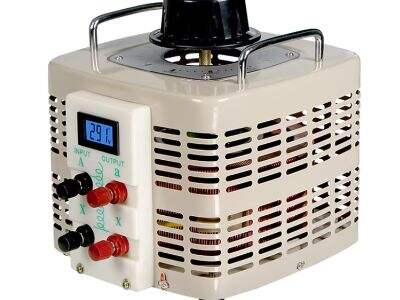Bộ ổn áp cố định so với điều chỉnh được
Bộ ổn áp cố định cung cấp điện áp đầu ra danh định, trong khi các loại điều chỉnh được có khả năng thay đổi điện áp. Tức là, một khi bạn xác định điện áp V, nó sẽ giữ nguyên. Ngược lại, bộ ổn áp điều chỉnh được có thể điều chỉnh điện áp đầu ra theo yêu cầu. Vì vậy nếu bạn cần nhiều mức điện áp khác nhau cho từng phần khác nhau của dự án, bạn nên xem xét việc sử dụng bộ ổn áp điều chỉnh được.
Các Yếu Tố Cần Cân Nhắc Khi Lựa Chọn Loại Ổn Áp
Có một vài yếu tố quan trọng cần cân nhắc khi lựa chọn giữa bộ ổn áp điện áp cố định và có thể điều chỉnh. Một điều cần xem xét là mức độ linh hoạt mà bạn yêu cầu. Nếu bạn biết chắc rằng mình luôn cần mức điện áp đầu ra như nhau, thì bộ ổn áp cố định thường là lựa chọn phù hợp. Tuy nhiên, nếu thiết bị của bạn sẽ cần các mức điện áp khác nhau vào những thời điểm khác nhau, có lẽ bộ ổn áp điều chỉnh được sẽ tốt hơn.
Điều thứ hai cần lưu ý là mức độ phức tạp của dự án bạn đang thực hiện. Bộ ổn áp điều chỉnh bộ điều chỉnh điện áp có thể hơi phức tạp hơn một chút khi sử dụng so với bộ ổn áp cố định, vì vậy nếu bạn đang học về điện tử, hoặc bạn đang thực hiện một dự án cơ bản, thì việc sử dụng bộ ổn áp cố định có thể đơn giản hơn.
Ưu điểm của Bộ ổn áp Điện áp Điều chỉnh
Bộ điều chỉnh điện áp có thể điều chỉnh được khá đa dụng, điều này đôi khi có thể rất hữu ích. Ví dụ, nếu bạn đang làm việc trên một ứng dụng cần nhiều mức điện áp khác nhau, bộ điều chỉnh có thể điều chỉnh giúp bạn nhanh chóng thiết lập điện áp đầu ra theo đúng nhu cầu cụ thể của bạn. Điều này có thể giúp bạn tiết kiệm thời gian và công sức so với phương án sử dụng nhiều bộ điều chỉnh cố định.
BỘ ĐIỀU CHỈNH ĐIỆN ÁP (AVR) các bộ điều chỉnh có điện áp đầu ra điều chỉnh được cũng có thể hoạt động trong dải điện áp đầu vào rộng hơn so với các bộ điều chỉnh cố định và có thể chấp nhận nhiều loại nguồn điện đầu vào khác nhau. Điều này sẽ rất tiện lợi nếu bạn đang thử nghiệm với nhiều loại pin hoặc nguồn điện khác nhau.
Lợi ích của Bộ Điều Chỉnh Điện Áp Cố Định
Một bộ điều chỉnh bộ điều chỉnh điện áp rất phù hợp cho các dự án mà chúng ta biết chính xác điện áp cần sử dụng. Bộ ổn định điện áp cố định ít gây hư hỏng hơn vì điện áp đầu ra của chúng luôn không đổi, do đó trong một số ứng dụng, chúng có độ tin cậy và đơn giản cao hơn. Chúng thường cũng rẻ hơn bộ ổn áp điều chỉnh được, vì vậy bạn có thể tiết kiệm được một khoản chi phí nếu không cần tính linh hoạt bổ sung.
Bộ ổn áp cố định cũng thường hiệu quả hơn so với bộ ổn áp điều chỉnh được. Điều này có nghĩa là chúng tiêu hao ít năng lượng hơn và tỏa nhiệt ít hơn, một yếu tố quan trọng trong các dự án mà hiệu suất năng lượng là ưu tiên hàng đầu.
Khi nào nên sử dụng bộ ổn áp điện áp cố định hoặc điều chỉnh được?
Vậy khi nào bạn cần một bộ điều chỉnh cố định thay vì một bộ điều chỉnh có thể điều chỉnh trong dự án điện tử của mình? Nói chung, nếu bạn cần một điện áp đầu ra cố định đơn giản và bạn có thể kiểm soát phía đầu vào - một bộ điều chỉnh cố định có lẽ là lựa chọn phù hợp. Nhưng nếu bạn muốn sự linh hoạt, khả năng dễ dàng thay đổi điện áp đầu ra, thì bạn có thể muốn chọn bộ điều chỉnh có thể điều chỉnh.
 EN
EN
 AR
AR
 FR
FR
 EL
EL
 HI
HI
 PT
PT
 RU
RU
 ES
ES
 TL
TL
 ID
ID
 UK
UK
 VI
VI
 TH
TH
 TR
TR
 FA
FA
 MS
MS
 AZ
AZ
 KA
KA
 UR
UR
 BN
BN
 GU
GU
 HA
HA
 IG
IG
 KM
KM
 LO
LO
 LA
LA
 MR
MR
 MN
MN
 NE
NE
 SO
SO
 TA
TA
 YO
YO
 ZU
ZU
 MY
MY
 KK
KK
 MG
MG
 KU
KU
 KY
KY
 SD
SD

